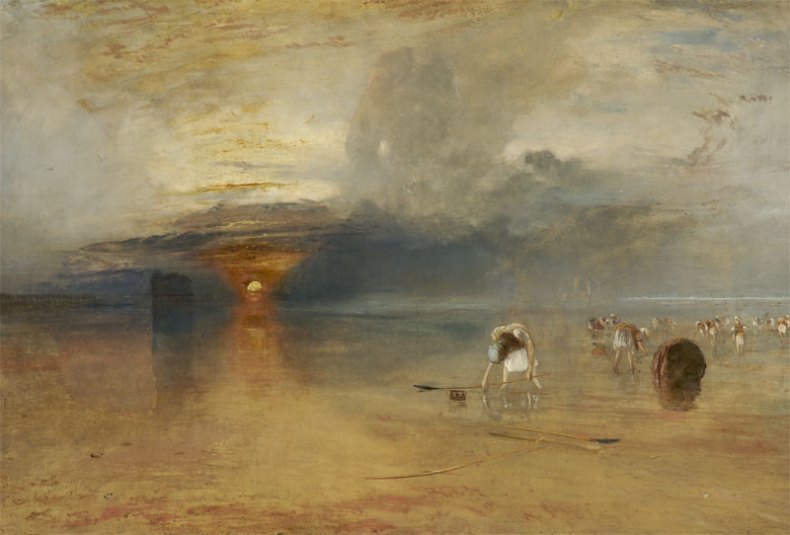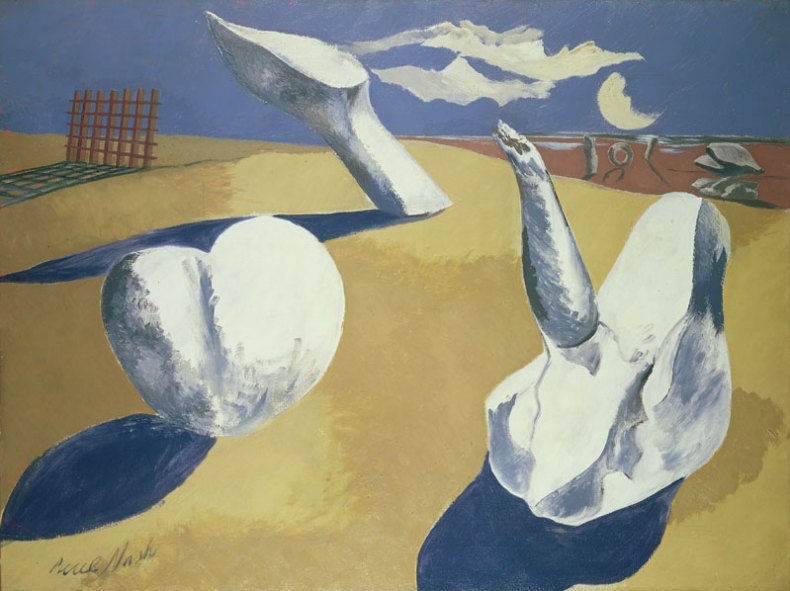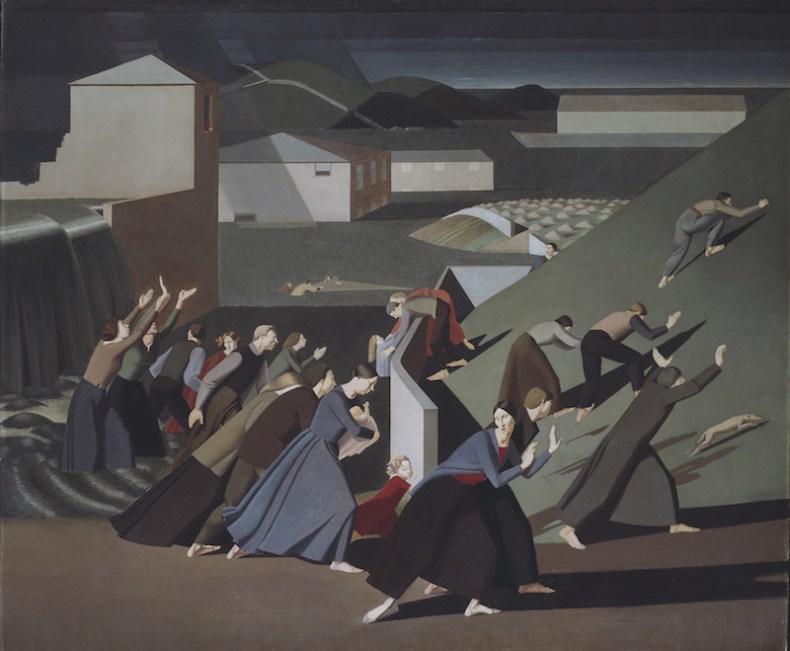British modernism is having a ‘moment’ and Jonathan Jones is displeased. We should be celebrating Turner and Stubbs, not half-baked losers like Paul Nash and Winifred Knights, artists whose achievements he believes amount to precious little in any right-minded history of art. Why is he so upset about this? Apparently, we should be looking at Turner and Stubbs to hone our cultural identity, something we need to agree on pretty sharpish ‘now Brexit is inevitable.’
It’s an arresting if unfathomable idea: does he mean that by immersing us in a visceral evocation of the British landscape Turner vouchsafes the essence of Britishness? Does Turner chime with us principally because we too are British? Does an Italian look at Ploughing Up Turnips, Near Slough (‘Windsor’), exhibited 1809, and know what it is to be British?

Calais sands at low water – Poissards collecting bait (1830), J.M.W. Turner © Bury Art Museum, Great Manchester
In fact, Jones seems to be coming at it from a more straightforwardly jingoistic angle, placing them in a ‘best of British’ line up alongside, presumably, Shakespeare, Austen and all the rest of the band. You continentals can keep your Picasso and Dix – stand back, we’ve got Turner.
But in accusing the champions of British modernism of ignorance and narrow-minded nationalism, Jones misses the whole point of the current raft of exhibitions. Far from stagnating in a backwater that failed to embrace the groundbreaking developments in mainland Europe, many British artists were engaged in a fruitful dialogue that crossed geographical boundaries.

Nocturnal Landscape (1938), Paul Nash. Manchester Art Gallery. © Tate
Tate Britain’s current exhibition wholeheartedly rejects the characterisation of Paul Nash as a parochial figure, concerned only with specifically English subject matter. He was fully immersed in avant-garde developments, embracing surrealism and experimenting with found objects, photography, collage and abstraction.
It is revealing that in Jones’s assessment, it isn’t good enough to be part of an endeavour, and ironically it is this peculiarly British pathology that has landed us in the mess we are currently in. For the Brexiteers, it was never enough for us to simply participate; for Jones, a British artist is only great if he’s leading the way.
The flipside of this absurd need to be in charge is the tendency for self-loathing, rejecting entirely anyone who doesn’t measure up as a Soviet-style people’s hero. It is an attitude that has allowed important, but unfashionable examples of British art to be dispersed all over the world, with one of the best collections of Victorian painting found not in Edinburgh or Birmingham, but in Puerto Rico.

The Deluge (1920), Winifred Knights. Tate, London. © The Estate of Winifred Knights
Perhaps the saddest thing about this approach is the way that it suppresses the idiosyncracies that make art history so vividly compelling. Whether you like it or not, the current reassessment of British modernism is a much-needed corrective to the limited but dominant view of 20th-century art as male, linear and non-figurative. Instead we see artists responding not just to one another, but to the world as they experienced it, presenting a fascinating, contradictory array of singular artists like Stanley Spencer, Eileen Agar, David Bomberg and Winifred Knights, to name a few.
If Brexit has taught us anything, surely it is wariness of the idea that we are as a nation united by common values. If we are going to look to art for guidance, we need to acknowledge our role in art history, whether as leader or cogwheel, so that we might take our place in a bigger narrative not confined by borders.

Wake up Jonathan Jones! British art is not just about Turner
The Fighting Temeraire tugged to her last berth to be broken up (1838), Joseph Mallord William Turner. Photo: © Bury Art Museum, Great Manchester
Share
British modernism is having a ‘moment’ and Jonathan Jones is displeased. We should be celebrating Turner and Stubbs, not half-baked losers like Paul Nash and Winifred Knights, artists whose achievements he believes amount to precious little in any right-minded history of art. Why is he so upset about this? Apparently, we should be looking at Turner and Stubbs to hone our cultural identity, something we need to agree on pretty sharpish ‘now Brexit is inevitable.’
It’s an arresting if unfathomable idea: does he mean that by immersing us in a visceral evocation of the British landscape Turner vouchsafes the essence of Britishness? Does Turner chime with us principally because we too are British? Does an Italian look at Ploughing Up Turnips, Near Slough (‘Windsor’), exhibited 1809, and know what it is to be British?
Calais sands at low water – Poissards collecting bait (1830), J.M.W. Turner © Bury Art Museum, Great Manchester
In fact, Jones seems to be coming at it from a more straightforwardly jingoistic angle, placing them in a ‘best of British’ line up alongside, presumably, Shakespeare, Austen and all the rest of the band. You continentals can keep your Picasso and Dix – stand back, we’ve got Turner.
But in accusing the champions of British modernism of ignorance and narrow-minded nationalism, Jones misses the whole point of the current raft of exhibitions. Far from stagnating in a backwater that failed to embrace the groundbreaking developments in mainland Europe, many British artists were engaged in a fruitful dialogue that crossed geographical boundaries.
Nocturnal Landscape (1938), Paul Nash. Manchester Art Gallery. © Tate
Tate Britain’s current exhibition wholeheartedly rejects the characterisation of Paul Nash as a parochial figure, concerned only with specifically English subject matter. He was fully immersed in avant-garde developments, embracing surrealism and experimenting with found objects, photography, collage and abstraction.
It is revealing that in Jones’s assessment, it isn’t good enough to be part of an endeavour, and ironically it is this peculiarly British pathology that has landed us in the mess we are currently in. For the Brexiteers, it was never enough for us to simply participate; for Jones, a British artist is only great if he’s leading the way.
The flipside of this absurd need to be in charge is the tendency for self-loathing, rejecting entirely anyone who doesn’t measure up as a Soviet-style people’s hero. It is an attitude that has allowed important, but unfashionable examples of British art to be dispersed all over the world, with one of the best collections of Victorian painting found not in Edinburgh or Birmingham, but in Puerto Rico.
The Deluge (1920), Winifred Knights. Tate, London. © The Estate of Winifred Knights
Perhaps the saddest thing about this approach is the way that it suppresses the idiosyncracies that make art history so vividly compelling. Whether you like it or not, the current reassessment of British modernism is a much-needed corrective to the limited but dominant view of 20th-century art as male, linear and non-figurative. Instead we see artists responding not just to one another, but to the world as they experienced it, presenting a fascinating, contradictory array of singular artists like Stanley Spencer, Eileen Agar, David Bomberg and Winifred Knights, to name a few.
If Brexit has taught us anything, surely it is wariness of the idea that we are as a nation united by common values. If we are going to look to art for guidance, we need to acknowledge our role in art history, whether as leader or cogwheel, so that we might take our place in a bigger narrative not confined by borders.
Unlimited access from just $16 every 3 months
Subscribe to get unlimited and exclusive access to the top art stories, interviews and exhibition reviews.
Share
Recommended for you
British artists at the seaside
Dorset had a profound impact on a group of Slade painters, as an exhibition at Bristol’s Royal West of England Academy makes very clear
‘This is the moment international attitudes to British art should change’
Christie’s celebrates the great tradition of British painting this month
It’s about time Winifred Knights got some attention
The Dulwich Picture Gallery finally spotlights this British modernist, whose work owes much to Renaissance traditions